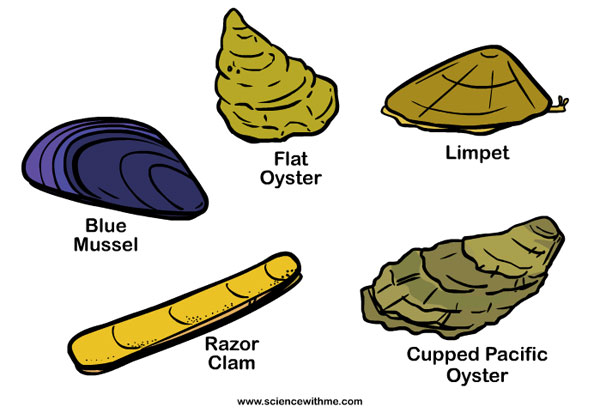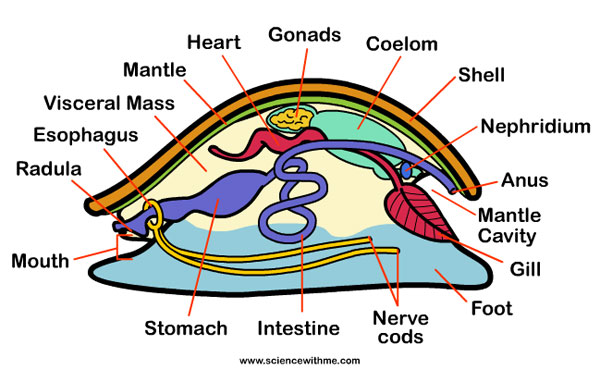Have you ever observed a snail travel from one point to another?
Isn’t it very slow? This is because it does not have feet which are like yours. It does not have the support and strength provided by your skeleton. A snail is just one of the many kinds of mollusks you might have already encountered. Other mollusks include the clam, the octopus and the squid.
What are mollusks?
Mollusks or molluscs belong to the phylum Mollusca. All of the members are invertebrates, which mean they lack backbones. This is perhaps the reason why they are named so. The origin of their name is the Latin word “mollis” which simply means “soft”. Indeed, even mollusks that have shells have a soft body inside.
 Aside from this distinguishing feature, they are also differentiated from other animals by the presence of the mantle and the unique organization of their nervous system. The nervous system of mollusks is unique in the sense that it only consists of nerve cords and ganglia. On the other hand, the mantle is an extension of a mollusk’s body wall. It is the organ that produces the shell by secreting calcium-based crystals or calcareous spicules. Beneath the mantle is the mantle cavity. Within this cavity, the mollusk’s gills, anus, and excretory pores can be found.
Aside from this distinguishing feature, they are also differentiated from other animals by the presence of the mantle and the unique organization of their nervous system. The nervous system of mollusks is unique in the sense that it only consists of nerve cords and ganglia. On the other hand, the mantle is an extension of a mollusk’s body wall. It is the organ that produces the shell by secreting calcium-based crystals or calcareous spicules. Beneath the mantle is the mantle cavity. Within this cavity, the mollusk’s gills, anus, and excretory pores can be found.
Where do mollusks live?
Note that gills were mentioned previously. The presence of gills allows mollusks to survive underwater. This is the reason why most mollusks live in oceanic habitats. However, many mollusks also live in freshwater and terrestrial habitats.
What are the special structures of mollusks?
Mollusks have a distinct anatomy. Aside from the shell, mantle, mantle cavity, nervous system, and gills mentioned earlier, mollusks also have a muscular “foot”. This foot has various functions but it is mainly used for movement and attachment. Most mollusks also have “radulae”. These are muscular structures used for scraping off their food from rock surfaces. In a sense, they are similar to your tongue and teeth, except that they are used for rasping rather than biting and chewing. Most mollusks have “metanephridia” which are organs for excretion of wastes. These organs are similar to your own kidneys.

What are the classifications of mollusks?
In the formal science of naming called taxonomy, mollusks are classified into ten classes: Aplacophora, Caudofoveata, Polyplacophora, Monoplacophora, Gastropoda, Cephalopoda, Bivalvia, Scaphopoda, Rostroconchia, and Helcionelloida. However, only the most familiar organisms will be discussed here. These organisms are members of the classes Gastropoda, Cephalopoda and Bivalvia.
-
Gastropoda: Members of this class are called gastropods. About 70-80% of all mollusk species are gastropods. The term Gastropoda means “stomach-foot” or “belly-footed”. The foot of gastropods secretes mucus for movement lubrication. Examples of gastropods with shells include the limpets, abalones and snails. You can download our snail coloring sheet worksheet below. Do not assume though that all gastropods have shells. Examples of gastropods which lack shells include slugs and nudibranchs.
-
Cephalopoda: The term cephalopod means “head-footed”. Unlike gastropods, which have a single muscular foot, cephalopods have “feet” which are attached to the “head” containing their eyes. The “feet”, which are also called “arms” or tentacles, are utilized for jet propulsion. Most cephalopods lack shells. In fact, the only cephalopod that has an external shell is the Nautilus. The main advantage of cephalopods over other mollusks is the presence of well-developed and large eyes. Although the cephalopod eye does not develop in the same process that the mammalian eye undergoes, it functions the same way. Therefore, a cephalopod, such as an octopus or a squid, can see the same way that you do. So what is the difference between an octopus and a squid? An octopus only has eight arms whereas a squid has ten. However, two of the squid’s arms are longer than the other eight. Since these two are used to grab prey, they are also called feeding tentacles. You can see the detailed body parts of a squid in our Squid Worksheet which can be downloaded for free.
-
Bivalvia: Members of this group are called bivalves because they have two shells. Many bivalves serve as food sources. The foot of bivalves is used either for burrowing or for attaching to wood or other material. Bivalves do not have radulae. This is the reason why they filter food particles from water instead of rasping from surfaces. One process that is unique to bivalves, particularly to clams, mussels and oysters, is pearl formation. When a grain of sand or some foreign body gets into the mantle of these bivalves, the bivalves secrete mother-of-pearl or “nacre” which coats the irritants. Since this is the same material that forms the inner lining of their shells, coating the foreign body makes it less irritating to the bivalves. This process is currently utilized by humans in order to stimulate oysters to produce high-quality pearls.
